In its liturgical calendar for December, the Catholic church celebrates each year a devotion to the Virgin Mary that has deep roots in and strong resonance for Latin American Catholicism. For those living in places in which there are not large concentrations of people from that part of the world, the feast of Our Lady of Guadalupe often comes and goes without notice.
I’ve long had a particular interest in the Guadalupe story, however—for personal reasons. My father died late on the night of the Guadalupe feast. And I later made a life-altering pilgrimage to the shrine of Our Lady of Guadalupe in Mexico City, at a period in which I was searching for my vocational path and needed to pray with others desperate to find meaning in their lives. In what follows, I’d like to reflect on the significance I’ve come to see in the Guadalupe story as I’ve struggled with it over the years—and, in particular, for what this story of the appearance of an Aztec holy maiden to an Aztec peasant implies about the ownership and interpretation of holy stories, including the biblical narratives.
As with so many holy stories, the Guadalupe story has gotten covered in layers of simpering piety that divert us from the central thread of the narrative. This is a story about holy intrusion into the life of an ordinary man, the lowest of the low in the society of his day. The story tells what happened when a simple indigenous Mexican man, Cuauhtlatoatzin, encountered the Virgin Mary on a hilltop one day near Tenochtitlan, now Mexico City.
Cuauhtlatoatzin heard birds singing on Tepeyac hill and, amidst the bird calls, his name. He climbed Tepeyac to see what this was about and saw there a Mexican girl surrounded by light, a dark-skinned girl of the people, rather than one of the conquistadors from Spain who had claimed his land. She spoke to him in his native language, Nahuatl, calling him Xocoyte, “little son.” He responded courteously, calling her “Xocoyata,” his least daughter.
The dark-skinned girl made a request of him. He was to go the bishop of Mexico, a Spaniard, and tell him that the girl wanted a “teocalli,” a holy house, built on Tepeyac. And so Cuauhtlatoatzin went to the bishop, Juan de Zumárraga, repeatedly. And was repeatedly turned away.
How, the bishop wondered, could the Virgin Mary appear to a Mexican peasant and not to a Spanish bishop or a priest, with centuries of the True Faith in his blood? The bishop asked for a sign. And for the sign, the girl produced roses from the bishop’s native land of Castile, wrapped them in her cloak, and gave this to Cuauhtlatoatzin to bring to the Spaniard. When Cuauhtlatoatzin shook out the roses, an image of the girl was imprinted on her cloak. Roses in December.
The bishop believed. The shrine of Guadalupe was built, becoming the center of Mexican Catholicism, a place to which the wretched of the earth go with as much hope of being received and heard as the fair-skinned and haughty, the wealthy and the wise.
These are the bare bones of the story, bones we don’t often see under the florid ornamentation that now covers their telling. Cuauhtlatoatzin now appears under the Spanish name St. Juan Diego. The dark-skinned girl is now a princess. The point of the story, as people tell it today, is to talk about the Virgin Mary and her miracles—not about God’s choice to enter this world in solidarity with the outcast, the despised, the conquered, the dark and dirty: the workers, those carriers of flowers Diego Rivera loved to depict, whose backs are stooped with the burdens they carry to prettify the lives of us, the privileged of the world. While they have no flowers for themselves. Except the roses in the cloak of the Aztec maiden. Roses in December.
This is a story for our time, once we probe beyond the hagiographical layers that distort what the story wants to say to us. It is a story about where God lives today, in our world. It’s an Advent story about the kind of God we should be expecting as we continue our journey in faith, watching for signs of the presence of God in the world in which we live, and living in hope for the eschatological fulfillment of creation. It’s a story about a homely God who comes to us in homely ways.
And it’s a story about who we might become, if we listened well to the gospels. It’s a story about rich nations that may choose to share their wealth with the despised of the world, that may open their doors to the huddled masses, that might one day acknowledge the manifold gifts those pouring through the doors bring to us.
It’s a story about tables where bread is broken and shared, so that everyone has enough—a story about how bread decays when it is hoarded, and becomes insufficient even for those who have hoarded it in abundance. It is a story about the choice of God and the holy ones to appear to those we least expect to become the bearers of divine gifts and messages.
Who knows, perhaps even to us, if we learn to imagine the world differently . . . .
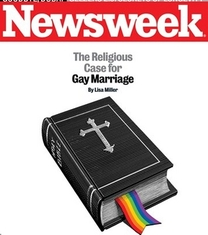 The Guadalupe story and what has been made of it over the course of time challenge us to ask, Who owns holy stories? That’s a question now being asked in many traditionally Christian cultures, regarding the place of gay and lesbian persons in God’s created world and in the scriptures. As Lisa Miller’s controversial December 2008 Newsweek article about the bible and gay marriage demonstrated, we are living through a cultural moment at which sharp battle lines have developed regarding the ownership of the holy stories of Judaeo-Christian scripture. Those battle lines are particularly apparent in the United States, and are emerging clearly once again in the prop 8 trial, where testimony is demonstrating that those opposed to same-sex marriage ultimately have no strong basis for their opposition except their belief that the bible forbids homosexuality.
The Guadalupe story and what has been made of it over the course of time challenge us to ask, Who owns holy stories? That’s a question now being asked in many traditionally Christian cultures, regarding the place of gay and lesbian persons in God’s created world and in the scriptures. As Lisa Miller’s controversial December 2008 Newsweek article about the bible and gay marriage demonstrated, we are living through a cultural moment at which sharp battle lines have developed regarding the ownership of the holy stories of Judaeo-Christian scripture. Those battle lines are particularly apparent in the United States, and are emerging clearly once again in the prop 8 trial, where testimony is demonstrating that those opposed to same-sex marriage ultimately have no strong basis for their opposition except their belief that the bible forbids homosexuality.
With regard to the place of gay human beings in God’s created world and the scriptures, the discussion has moved on—quite some time ago, in fact—from questions about whether the bible “approves” or “disapproves” of homosexuality, or about the precise meaning of the tiny handful of texts that anti-gay believers mull obsessively as they try to turn a molehill of biblical ambiguity into a mountain of homophobic certainty.
This is, in fact, why the Newsweek article provoked such controversy. It points out how far we have moved, as a culture and as people of faith, away from the need to justify the existence of gay persons and towards full cultural (if not full ecclesial) inclusion. Miller’s article takes for granted what has become obvious: the scriptures do not condemn homosexuality; they do not condemn same-sex marriage. They do not dictate a one man-one woman model for marriage.
What they do clearly, instead, is tell us to love: to live practical compassion—a concept that, as Karen Armstrong and Desmond Tutu remind us, forms the core of the teaching of all world religions. The scriptures tell us first and foremost to love and to avoid hate. The vast weight of scriptural testimony about who God is and what God calls people to do is on the side of love and not hate. On the side of welcoming, including, according full humanity and full personhood to every person God has created, including those God has made gay. The weight of scripture is not on the side of gay bashing.
Because this has become increasingly evident in the cultural debate about the scriptures and homosexuality, Christians determined to resist the full inclusion of gay and lesbian persons in church and society have shifted their attack on gay people from select scripture verses to what the former governor of Arkansas (and ordained Southern Baptist minister) Mike Huckabee calls the “anatomical” case for the normativity of heterosexual marriage. Huckabee used this term in an interview with Jon Stewart in the same month in which Lisa Miller’s Newsweek article was published. Rev. Huckabee’s contention is that the normativity of male-female marriage is written “anatomically” into nature itself, in the body parts of men and women.
These simplistic biological claims (which our longstanding practice of marrying heterosexual couples who cannot and will not procreate subvert) are attempts to shift the conversation about how the bible connects to gay people and gay lives. These claims are an attempt to divert attention from the fact that 1) there is not a strong basis at all in scripture for the hateful animus many people of faith continue to want to nourish towards gay persons; and 2) there is a strong scriptural basis for an opposite approach to gay human beings, one that prioritizes love over hate.
Anti-gay Christians like Rev. Huckabee want to shift the terms of the conversation about the bible and homosexuality because they recognize that the real issue at stake has become not how and whether the bible is preoccupied with condemning gay people (it clearly is not). The real issue at stake—one far more threatening to those who imagine they have always owned the bible and have exclusive right to tell the rest of us what it means—is the question of who owns our holy stories.
And who has the right to interpret them. To interpret them for the rest of us. To shut the rest of us up, when we disagree with the “official” interpretation.
Over the course of history, it’s clear that, for most Christians, men—presumably straight men—have had that exclusive right to own, read, interpret, and enforce their “official” reading of the scriptures for everyone else. Only recently, with the rise of the women’s movement and its gradual influence in the Christian churches, has that claim to heterosexual male ownership of the scriptures been seriously contested.
Perhaps the most radical way in which many women (and people of color, and LGBT people) are now contesting the claim of straight (or straight-posing) males to exclusive ownership of the bible and its interpretation is the refusal of these groups to listen, when they are told to do so. When they are told to listen by the exclusive owners and “official” interpreters of the holy stories of our faith communities.
Women, people of color, LGBT people and other historically marginalized people have begun to read and interpret the scriptures with a vengeance. Using their own optics. Seeing with their own eyes. Hearing with their own ears. This subversive process of re-reading and re-interpreting the holy books by historically marginalized groups is at the heart of the liberation movement in the Christian churches—and, in large degree, it accounts for the fierce opposition of those at the top of many churches to this movement.
This subversion of the traditional ownership and interpretation of the bible is beginning to put the shoe on the other foot within many Christian churches. This process of retelling and rethinking the formative holy stories of our religious traditions is beginning to make it impossible for those who have long claimed exclusive ownership of these to avoid listening to alternative readings of these stories arising out of the experience of marginalization.
Perhaps one of the most significant developments in many churches in the latter part of the 20th century and at the start of the 21st century is the assertion by many historically marginalized communities of their right to hear something radically different in the scriptures. As women, people of color, LGBT persons, and other marginal groups have begun to read the bible through the optic of their experience of marginalization, daring to speak forth what these stories say to them, communities of alternative discourse have begun to develop around readings of the holy stories that enliven rather than continue the oppression of these communities.
Nothing so disrupts and subverts the fictive claim to ownership of the scriptures by the big men (and big women) of the world as the stolid persistence of these marginalized communities in claiming the holy stories as their birthright, as well. The holy stories, historically marginalized groups are insisting, belong not only to those at the top of the social and economic ladder.
They belong to the overlooked and bypassed, as well, to those denigrated and shoved to the margins by the mechanisms of power in various social groups. The scriptures may well belong to these groups in a deeper sense, in fact, than to those at the top, because a great deal of what the scriptures say is opaque to those at the top but crystal-clear to those at the bottom.
In the final analysis, those who entertain the illusion that they own the scriptures do not do a very thorough job of reading them, of struggling with all that they have to say. This is the case, liberationist interpreters of the bible have begun to insist, because the lives of those with privilege are hardly conducive to struggle or to nuance. Not to existential and spiritual struggle and nuance, and it is that kind of struggle that is necessary if we want to hear holy stories at a depth level. As long as what we own or our illusion of power over others allows us to imagine that we are shielded from the struggles that are the common lot of most people in the world, we cannot hear what holy stories try to speak to us.
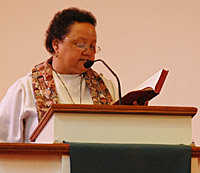 Those at the bottom recognize more clearly than those at the top that, properly approached, hearing holy stories requires anguish and struggle. Those at the bottom know that holy stories and holy books can never be owned, certainly not in the official (and officious) way in which the big men and big women at the top think they own God’s word. Holy stories and holy books claim us, instead. We spend our lives trying to come to terms with the terrifying, life-altering, marvelous recognitions they open to us—with the God to whom they point, who can never be shut up in a book or controlled or owned, even by the powerful of the earth.
Those at the bottom recognize more clearly than those at the top that, properly approached, hearing holy stories requires anguish and struggle. Those at the bottom know that holy stories and holy books can never be owned, certainly not in the official (and officious) way in which the big men and big women at the top think they own God’s word. Holy stories and holy books claim us, instead. We spend our lives trying to come to terms with the terrifying, life-altering, marvelous recognitions they open to us—with the God to whom they point, who can never be shut up in a book or controlled or owned, even by the powerful of the earth.
In my view, as a gay believer, it is necessary for those of us reading the scriptures from the standpoint of our experience as gay and lesbian persons to stop trying to convince the Huckabees of the world that the scriptures “endorse” or “approve” or “include” gay human beings. It is time for us, instead, simply and boldly to claim our right to read and interpret the holy stories of our religious traditions. On our own terms.
It is time to demonstrate that the official readings of many of our churches and the men who rule us are just beside the point. Their official reading of the bible makes little difference to anyone’s life, not at any level that counts. These official interpretations are not infrequently as empty, as glib, as superficial, as those producing these interpretations—as incapable of offering many of us spiritual direction as those spouting nonsense about the only possible way to interpret the bible that they believe they own exclusively.
In the final analysis, nothing is more subversive than just living, when one is denied the right to live—living large when you are told to subsist on a crust of bread and a rind of cheese; living confidently when you are told to live apologetically. Nothing may end up healing our culture so pocked with biblical nonsense, in this nation with the soul of a church, more than for those who are as much heirs of the holy stories as the big men and big women of the world, and who recognize the nonsense for what it is, to wrest control of the holy stories from those who “own” them.
And to begin reading them with new eyes, with sight sharpened by the experience of exclusion and privation. And to form new communities of interpretation and praxis within the shells of moribund communities of faith that have mistakenly waged the future of the churches on the maintenance of patriarchy—new communities centered on alternative discourse, gathered around and energized by new readings of the ancient stories that form our religious heritage.
(Cross-posted from Bilgrimage 11 Dec. 2008 [and here] with editorial changes)
Filed under: church reform, Scripture Reflections | Tagged: bible, changing church, gay theology, scripture, Scripture Reflections, women's movement |


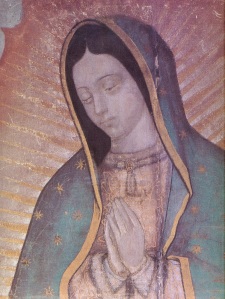
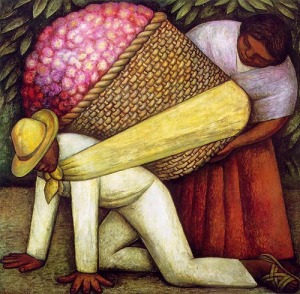

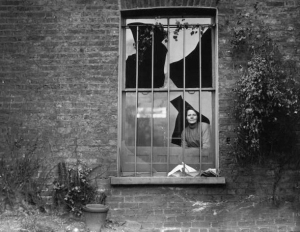
“The point of the story, as people tell it today, is to talk about the Virgin Mary and her miracles—not about God’s choice to enter this world in solidarity with the outcast, the despised, the conquered, the dark and dirty”
As far as I can tell, the “official” story to which you so object is and has always been about both. I say so as a resident of New Mexico, where Our Lady of Guadalupe has long been a living presence.
There is nothing anyone can do, of course, if you wish to “appropriate” her name and image for other causes. But the idea that the scriptures and the saints can mean whatever we individually want them to mean strikes me as a profoundly un-Catholic idea.
Thanks for your reply.
But I wonder what version of my article you can have read, to come away from your reading with such unfounded judgments about it.
Where do I say that I “so object” to the official reading of the story of Guadalupe?
Or that I believe that the scriptures and saints “can mean whatever we individually want them to mean”?
I’m afraid you’ve completely misread my points.
You present the story in terms of a contrast between a “patriarchal” reading focusing on “the virgin Mary and her miracles” (with its “simpering piety”) in contrast to “God’s choice to enter this world in solidarity with the outcast, the despised, the conquered, the dark and dirty.” My simple point was that the story in the Church encompasses both (inclduing the simpering piety). There is no either/or in my hearing of the story in the parish, in the local shrine, in the fiesta.
Re-interpretation? You say, “The real issue at stake—one far more threatening to those who imagine they have always owned the bible and have exclusive right to tell the rest of us what it means—is the question of who owns our holy stories. And who has the right to interpret them.”
At the risk of being a one-note Johnny, the teaching of the Second Vatican Council in the dogmatic constitution on revelation is fairly clear about the right to interpret:
“Sacred tradition and Sacred Scripture form one sacred deposit of the word of God, committed to the Church. Holding fast to this deposit the entire holy people united with their shepherds remain always steadfast in the teaching of the Apostles, in the common life, in the breaking of the bread and in prayers, so that holding to, practicing and professing the heritage of the faith, it becomes on the part of the bishops and faithful a single common effort. But the task of authentically interpreting the word of God, whether written or handed on, has been entrusted exclusively to the living teaching office of the Church, whose authority is exercised in the name of Jesus Christ.”
In contrast to the unity called for by the Council, you assert that “Nothing may end up healing our culture so pocked with biblical nonsense, in this nation with the soul of a church, more than…to wrest control of the holy stories from those who “own” them. And to begin reading them with new eyes, with sight sharpened by the experience of exclusion and privation. And to form new communities of interpretation ….”
With respect, people have been forming new communities of interpretation from the very beginning. There’s nothing much new about it. But I don’t know from whom a Catholic would “wrest” this interpretation from, other than from those to whom long tradition, and Dei Verbum, recognize as having that right of interpretation.
Patriarchal? But, again, I have to insist that you’re reading into my posting what’s not there at all. I never use the word “patriarchal” to refer to the hagiographical interpretations of Guadalupe that have obscured the culturally-rooted aspects of this story.
That’s your reading, not mine. And it imposes onto the text what’s not there. This is the opposite of what I’m talking about throughout the entire posting. I’m talking about reading holy stories within the context of communities of faith and practice that seek to take the text seriously, wrestle with it, respect it, and energize their communities’ faith and practice on the basis of such close, faithful reading of these stories.
Your attempt to call such acts of interpretation subjective is wildly wrong.
I do understand what lies behind it, since that’s been consistent throughout all your posting on this blog. You see some area of “objectivity” that is accessible and obvious to you and other privileged observers, from which you can then critique left and right.
But there is no act of reading or interpretation that is not already committed. We read from where we stand.
It’s clear that, while you claim to be detached from both left and right, you actually stand with those who believe they have the right to interpret holy texts for the rest of us. That is, you stand with those who have power and privilege in our world.
The changing narrative behind the story of Guadalupe reminds me of so many other points where the original words of Scripture have been distorted over the centuries to conform to the social preferences or prejudices or the time: of the apostle Junia, clearly a woman and taken so by the earliest commentators, but later adjusted in gender to conform with the belief that the apostles were necessarily male; or the Roman centurion’s “pais”, softened in translation to “servant”, to mask the probable real nature of the relationship; or “malakoi” and “arseneketoi”, notoriously mistranslated as “sodomites” in the KJV.
But your wider point is important too. To apply specifically feminist or queer readings to stories such as Guadalupe, or to Scripture itself, is not to “misappropriate” them to make a political point – it is to provide a balance to the way in which so much of our received interpretations have been distorted (inevitably) by the interpretations promoted by patriarchal, heterosexual theology.
Terry, thank you. You’ve seen my point clearly. You’re exactly right when you say, “To apply specifically feminist or queer readings to stories such as Guadalupe, or to Scripture itself, is not to ‘misappropriate’ them to make a political point – it is to provide a balance to the way in which so much of our received interpretations have been distorted (inevitably) by the interpretations promoted by patriarchal, heterosexual theology.”
The Catholic tradition has always recognized the need to keep reading the scriptures from new vantage points at new points in history. That’s why, liturgically, we keep on reading the stories. Over and over. The scriptures don’t reveal their full significance without that process of interpretation from new vantage points that become possible only as cultures shift and time moves on.
One other point I wanted to make in this posting: reading the holy stories “from below,” from the experience of historic marginalization, not only balances many of the official readings. It corrects them.
It corrects them because those of us who imagine we are in control of the world and have the keys to understanding it can’t ever begin to understand the significance of a text that is all about subverting precisely those expectations.
“You see some area of “objectivity” that is accessible and obvious to you and other privileged observers, from which you can then critique left and right.”
I don’t think so. I’m trying to counteract a widespread polarization that I think you are promoting.
To analyze the faith in terms of “right” and “left” is to impose inapplicable categories. Interpretation is indeed an inevitable process. You can’t read without interpreting. But when one comes to a crossroad, the whole community must sometimes choose. We Catholics have generally done that in our general councils.
Thefaith is both progressive and traditional. Doctrine develops, but in accord with what has gone before. God continues to speak, but I think we judge rightly that he doesn’t contradict himself. Thinkers and artists and activists push the envelope of the faith, and bishops react, and sift, and judge. It is in that process that the faith stays alive. The “patriarchs” are not the end-all and be-all of the Church. But they have an important function, to keep the Church from the fracturing normal to all social bodies, to provide an interpretation when the normally harmless cacaphony of diverse opinions reaches a point where unity is threatened, where disagreement has become civil war.
“I’m talking about reading holy stories within the context of communities of faith and practice that seek to take the text seriously, wrestle with it, respect it, and energize their communities’ faith and practice on the basis of such close, faithful reading of these stories.”
If that’s all you’re talking about, who can argue with it? But you also speak of those who “own” the stories, who are differentiated from those whom must now take the stories themselves. Who exactly are you talking about?
To a certain extent, we’re talking about apples and oranges here. You’re hearing (and talking about) doctrinal definition, and who does the defining. I’m hearing and talking about the reading of scriptures within communities of faith and practice who try to break open the bread of God’s word to energize their faith and the practice of the community.
I don’t dispute the need for doctrinal definition or arbitration about the direction we should go as a church. But when that definition and arbitration intrude on the process by which communities of faith, at their local levels, read scripture and seek to make it alive for their communities, something is awry.
Magisterial teaching ought to be the final outcome of a process of listening on the part of the church’s pastors, in which the pastors seek to discern the activity of the Spirit in local communities, among the faithful, and then in the entire body of Christ.
When we start from the premise that the reading and breaking open of God’s word among local communities of faith–including socially and ecclesially marginalized communities–is somehow a threat to the magisterium or an exercise in subjectivity that departs from magisterial teaching, we thwart the Spirit. We don’t allow the practice of faith in local communities even to get off the ground.
And asking questions about the political implications of church teaching and of scripture (left and right) isn’t creating an artificial division in the church. Those questions are right there in the midst of the church, since we live our faith in the real world–where these political options exist and have implications for how we live our faith.
And none of what I say above even touches on the fact that the magisterium sometimes comes to see and to admit that its teaching in a particular area has simply been wrong–as with usury, slavery, and the rights of women. That process cannot happen if the faithful aren’t allowed to read, think about, and respond to the scriptures faithfully and, yes, critically.
And it can’t happen if the pastors of the church ignore the sensus fidelium that develops in response to this practice of faith within communities reading, reflecting on, and responding to the scriptures–and which sometimes corrects positions taken by the magisterium.
Here we agree much more, that there is always something new and surprising to be found in scripture and tradition, that the poor and marginalized have a perspective that is ignored at our peril, that nothing but good will come out of a laity that is educated and willing to read critically. I hope I do not understand the tradition uncritically, but a thoughtful stance, to me, must be just as critical of the critics as of the tradition.
If I have misunderstood you I apologize, but when speaking of conflict in the Church, it would be well to be more specific. Mike Huckaby is not exactly a Catholic authority, and I can’t imagine how anything he says can have any significance for us (or even for Baptists, since they recognize no magisterium outside of the scriptures).
And certainly church authorities should be cautious in intervening ham-handedly–it’s a delicate line they have to walk. The fact that the right thinks them a bunch of wimps and the left thinks them little Torqumadas suggests to me, though, that they aren’t too far from the right path.
Yes, I think we do find common ground in the areas you mention–and I’m glad that’s the case.
I don’t think I can agree, however, that Mike Huckabee has little significance for us as Catholics. We live in a culture deeply imbued with the ideas and values of evangelical religion. We ignore it at our peril.
And, in their wisdom, the leaders of the U.S. Catholic church (and, indeed, of the Vatican, too) have chosen to ally themselves with the religious right in the U.S. around issues of “family” values, sexual morality, and abortion. As a result, many American Catholics uncritically imbibe ideas and values of the right wing of American evangelicalism, and believe that, in doing so, they have the blessing of their bishops and of Rome.
Our Lady of Guadalupe is a fascinating story for me precisely because the Church has not understood part of the message. Mary’s appearance to Juan Diego assured him that the Franciscans did indeed bring knowledge of Holy Ones with them. Holy Ones Juan recognized instantly as part and parcel of his Indigenous beliefs. They were not Beings who superceded Indigenous beliefs but Beings who facillitated and complemented the Indigenous Holy Ones which were already recognized. Hence the obvious Aztec symbolism in the clothing of Mary and the fact she was pregnant.
Appearing in the guise Mary appeared in also had huge political repercussions in that it helped stop what could have been a disasterous genocidal war.
There was much that Catholicism could have learned and still could learn from the Indigenous understanding of this event. A lot of it has to do with how different worlds intersect with our world. But that takes having ‘ears to hear’ and ‘eyes to see’ and a head that doesn’t dominate the heart.
Colleen, thank you! You’ve hit exactly on what I was critiquing in some of the hagiographical interpretations of the Guadalupe story. My critique didn’t have anything at all to do with patriarchal distortions–at least, certainly not consciously so.
I was pointing to the way in which the most significant feature of the story for most Latino Catholics–insofar as I understand a version of Catholicism to which I’m an outsider–is the fact that Mary is indigenous in the story. The distortion of much hagiography is that it overlooks the core of the story: that Mary chose to appear to an Aztec peasant as an Aztec maiden.
And so you are absolutely right: if we had listened to the story (and the experience of the faith communities originally telling it), we might have learned a tremendous amount about what it means to live the gospel in a non-European context. Global Catholicism could, if it had chosen to listen to this story carefully, learned much from what the story actually says. But to learn that “much” requires that the center listen to the margins . . . .
I also take for granted that all hagiographical stories become overlaid, in the course of time, with pious accretions that often distort the underlying narrative. For instance, many canonized women were right in the face of popes during their lifetime.
But when they became canonized saints, their cults began to depict them as submissive, obedient daughters of the church who never opened their mouths when they thought the leaders of the church were leading the church astray.
[…] that ensued when the ELCA made this decision, I offer it here as a companion piece to my last posting at Open Tabernacle, about the ownership and interpretation of holy stories. As the discussion following that posting […]